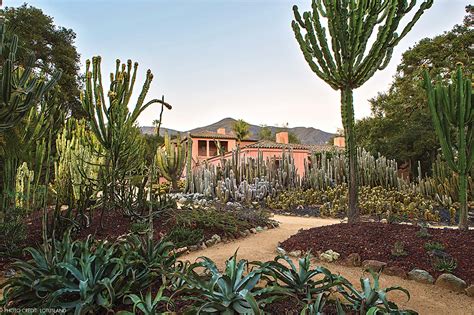Tucked away in the picturesque Mission Canyon area of Santa Barbara, California, the Santa Barbara Botanic Garden is a haven for nature lovers and those seeking solace in the beauty of the natural world. This 78-acre botanical garden is one of the oldest in the United States, founded in 1926 with a mission to conserve and promote the region’s unique flora. As visitors meander through the garden’s serene landscapes, they embark on a journey through the diverse plant communities of California, from the redwood forests to the coastal dunes.
The garden’s exceptional design and careful stewardship have created an environment that not only showcases the beauty of California’s native plants but also provides a habitat for a wide range of wildlife. The sound of birdsong fills the air as one walks along the winding paths, passing by a variety of flora, including trees, shrubs, and wildflowers that are native to the state. Among the garden’s notable collections are the rare and endangered plants of California, conserved and propagated to protect the state’s biodiversity.
Historical Evolution of the Garden
The concept of a botanical garden in Santa Barbara was first proposed in the early 20th century by a group of botanists and horticulturists who recognized the importance of preserving the region’s unique plant species. Initially, the garden was established on a smaller plot of land but was later relocated to its current site in Mission Canyon, which offered more space and a diverse range of microclimates ideal for cultivating a wide variety of plants.
Over the years, the Santa Barbara Botanic Garden has evolved to include educational programs, research initiatives, and conservation efforts. It has become a center for botanical knowledge, offering insights into the identification, cultivation, and preservation of California’s native plants. The garden’s library, which contains an extensive collection of botanical literature and herbarium specimens, is a valuable resource for researchers and enthusiasts alike.
Comparative Analysis of Botanical Gardens
While there are numerous botanical gardens around the world, each with its unique charm and focus, the Santa Barbara Botanic Garden stands out for its dedication to the flora of California. In comparison to other gardens that may have broader collections of plants from around the globe, the Santa Barbara Botanic Garden’s specialized focus allows for a deeper exploration and understanding of the plant communities within its region.
For instance, the San Francisco Botanical Garden, located in Golden Gate Park, features a diverse range of plant species from various parts of the world, including a significant collection of plants from the Mediterranean climate, similar to that of California. However, the Santa Barbara Botanic Garden’s emphasis on native California flora provides visitors with a unique opportunity to explore and learn about the local ecosystem.
Expert Insight: Conservation Efforts
Future Trends in Botanical Gardens
As concerns about climate change, biodiversity loss, and environmental sustainability grow, botanical gardens like the one in Santa Barbara are playing an increasingly important role in conservation and education. Future trends in botanical gardens are likely to include expanded conservation programs, more extensive community engagement, and innovative approaches to sustainability and environmental stewardship.
The integration of technology, such as plant DNA analysis and advanced irrigation systems, will also become more prevalent, helping gardens to better manage plant collections and reduce their environmental footprint. Additionally, there will be a greater emphasis on creating resilient gardens that can adapt to the challenges posed by climate change, ensuring the long-term viability of these important cultural and ecological institutions.
Technical Breakdown: Garden Design and Management
The design and management of the Santa Barbara Botanic Garden are intricate processes that involve careful planning, maintenance, and attention to detail. The garden is divided into several sections, each representing a different ecosystem found in California, such as the coastal sage scrub, the chaparral, and the redwood forest. This design allows visitors to experience the diversity of the state’s flora and understand the ecological relationships between different plant species and their environments.
Decision Framework: Visiting the Garden
For those considering a visit to the Santa Barbara Botanic Garden, several factors can help decide the best time and how to make the most of the visit:
- Seasonal Interest: Different seasons offer unique experiences, with spring being the peak time for wildflowers and fall ideal for enjoying the cooler weather and foliage changes.
- Guided Tours: Taking a guided tour can provide deeper insights into the garden’s history, plant collections, and conservation efforts.
- Personal Interests: Visitors with specific interests, such as photography, bird watching, or plant identification, can plan their visit accordingly, bringing necessary equipment or consulting with garden staff for advice.
Thought Experiment: A Day in the Garden
Imagine spending a day in the Santa Barbara Botanic Garden, surrounded by the sights, sounds, and scents of California’s native flora. As the sun rises over the mountains, the garden comes alive with the songs of birds and the gentle rustle of leaves in the morning breeze. With each step along the garden paths, a new discovery awaits—whether it’s the vibrant bloom of a ceanothus, the majestic stature of a coast redwood, or the delicate petals of a California poppy.
As the day unfolds, one might participate in a guided tour, attend a workshop on native plant gardening, or simply find a quiet spot to observe the natural beauty of the garden. The experience is not just a visit to a botanical garden but an immersion in the natural history and ecological heritage of California, fostering a deeper appreciation for the importance of conservation and the beauty of the natural world.
FAQ Section
What are the gardens' hours of operation?
+The Santa Barbara Botanic Garden is open daily from 9 AM to 5 PM, with extended hours during the summer months. It is recommended to check the garden's website for any special closures or hour changes before planning a visit.
Can I bring my pet to the garden?
+Due to the garden's role in conservation and its status as a wildlife habitat, pets are not allowed within the garden, with the exception of service animals.
Are there dining options available at the garden?
+Yes, the garden features a cafe that offers light meals, snacks, and beverages, using locally sourced ingredients whenever possible. There are also picnic areas for those who prefer to bring their own food.
The Santa Barbara Botanic Garden is more than a collection of plants; it is a gateway to understanding and appreciating the natural beauty and ecological importance of California’s flora. Through its conservation efforts, educational programs, and beautiful gardens, it inspires a sense of wonder and a commitment to environmental stewardship in all who visit.



